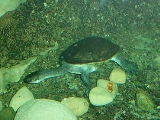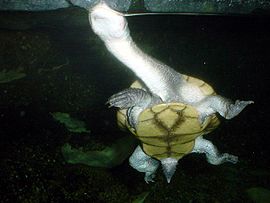
Roti Island Snake-necked Turtle
Encyclopedia
The Roti Island snake-necked turtle (Chelodina mccordi) is an extremely threatened turtle species from Rote Island
south west of Timor
between New Guinea
and Australia
. It belongs to the genus Chelodina
(Australian snake-necked turtles) within the family of Side-necked turtles (Chelidae
)
and regarded as distinct species in 1994 after Dr. Anders Rhodin, director of the Chelonian Research Foundation in Lunenburg (Massachusetts)
, found out that there are differences between the two species. The first snake-necked turtles on Roti Island were discovered in 1891 by George Albert Boulenger
. They were named for Dr. William McCord, a veterinary and turtle expert from Hopewell Junction
, New York.
The carapace
can reach a length between 18 and 24 centimetres. The length of the neck is similar. The color of the carapace is pale grey brown. Occasionally there are also specimens which have a chestnut coloured hue. The plastron is pale buff white. The neck is dark brown on the upperparts with round tubercles. The underparts are beige white. The iris is black surrounded by a white ring. Its habitat are swamps, rice terraces, and small lakes.
 The Roti Island Snake-necked Turtle is one of the most desired turtles in the international pet trade. Even before it was scientifically described it was so over-collected that the legal trade was prohibited in 2001 due to its rarity. The two or three remaining populations live in an area of only 70 km² in the central highlands of Roti Island. It is still illegally captured and it is often offered on markets under the label of the New Guinea Snake-necked Turtle which is also legally protected. In 2004 it was listed in Appendix II of CITES.
The Roti Island Snake-necked Turtle is one of the most desired turtles in the international pet trade. Even before it was scientifically described it was so over-collected that the legal trade was prohibited in 2001 due to its rarity. The two or three remaining populations live in an area of only 70 km² in the central highlands of Roti Island. It is still illegally captured and it is often offered on markets under the label of the New Guinea Snake-necked Turtle which is also legally protected. In 2004 it was listed in Appendix II of CITES.
Outside of capture by humans there are few natural threats to this species. There are some reports of predation by feral pigs (Sus Scrofa) and loss of habitat, however illegal capture and trade remains the primary threat.
Rote Island
right|thumb|300px|Satellite photo of RotiRote Island is an island of Indonesia, part of the East Nusa Tenggara province of the Lesser Sunda Islands. It has an area of . It lies northeast of the Australian coast and northeast of the Ashmore and Cartier Islands. The island is situated to the...
south west of Timor
Timor
Timor is an island at the southern end of Maritime Southeast Asia, north of the Timor Sea. It is divided between the independent state of East Timor, and West Timor, belonging to the Indonesian province of East Nusa Tenggara. The island's surface is 30,777 square kilometres...
between New Guinea
New Guinea
New Guinea is the world's second largest island, after Greenland, covering a land area of 786,000 km2. Located in the southwest Pacific Ocean, it lies geographically to the east of the Malay Archipelago, with which it is sometimes included as part of a greater Indo-Australian Archipelago...
and Australia
Australia
Australia , officially the Commonwealth of Australia, is a country in the Southern Hemisphere comprising the mainland of the Australian continent, the island of Tasmania, and numerous smaller islands in the Indian and Pacific Oceans. It is the world's sixth-largest country by total area...
. It belongs to the genus Chelodina
Chelodina
This large and diverse genus of long-necked Chelid turtles has had a complicated nomenclatural history. Although in the past the following have been considered separate genera and prior to that all the same, they are now considered sub-genera of the one genus....
(Australian snake-necked turtles) within the family of Side-necked turtles (Chelidae
Chelidae
The Chelidae are one of the three living families of the turtle suborder Pleurodira and are commonly called the Austro-South American Side Neck turtles. The Family is distributed in Australia, New Guinea, parts of Indonesia and throughout most of South America. It is a large family of turtles with...
)
Description
The Roti Island snake-necked turtle was split from the New Guinea snake-necked turtleNew Guinea Snake-necked Turtle
The New Guinea snake-necked turtle is a species of turtle in the Chelidae family.It is found in Australia, Indonesia, and Papua New Guinea.-References:...
and regarded as distinct species in 1994 after Dr. Anders Rhodin, director of the Chelonian Research Foundation in Lunenburg (Massachusetts)
Lunenburg, Massachusetts
Lunenburg is a town in Worcester County, Massachusetts, United States. The population was 10,086 at the 2010 census.For geographic and demographic information on the census-designated place Lunenburg, please see the article Lunenburg , Massachusetts....
, found out that there are differences between the two species. The first snake-necked turtles on Roti Island were discovered in 1891 by George Albert Boulenger
George Albert Boulenger
George Albert Boulenger FRS was a Belgian-British zoologist who identified over 2000 new animal species, chiefly fish, reptiles and amphibians.-Life:...
. They were named for Dr. William McCord, a veterinary and turtle expert from Hopewell Junction
Hopewell Junction, New York
Hopewell Junction is a hamlet in Dutchess County, New York, United States. The population was 2,610 at the 2000 census...
, New York.
The carapace
Carapace
A carapace is a dorsal section of the exoskeleton or shell in a number of animal groups, including arthropods such as crustaceans and arachnids, as well as vertebrates such as turtles and tortoises. In turtles and tortoises, the underside is called the plastron.-Crustaceans:In crustaceans, the...
can reach a length between 18 and 24 centimetres. The length of the neck is similar. The color of the carapace is pale grey brown. Occasionally there are also specimens which have a chestnut coloured hue. The plastron is pale buff white. The neck is dark brown on the upperparts with round tubercles. The underparts are beige white. The iris is black surrounded by a white ring. Its habitat are swamps, rice terraces, and small lakes.
Reproduction
A clutch can consist of eight to fourteen eggs and it can have three breeding periods in one year. The size of the eggs is 30 x 20 mm and the weight can reach eight to ten grams. The first hatchlings come after three months, the last after four months. When they hatch they have a size of 28 x 20 mm and they have yellow spots on the plastron which become darker with the time until the plastron becomes almost black after a few weeks. During the growing period the coloring becomes more pale until they finally reach the color of the adults.Threats

Outside of capture by humans there are few natural threats to this species. There are some reports of predation by feral pigs (Sus Scrofa) and loss of habitat, however illegal capture and trade remains the primary threat.
External links
- Asian Turtle Trade Working Group 2000. Chelodina mccordi. In: IUCN 2006. 2006 IUCN Red List of Threatened Species.
. Downloaded on 27 July 2006. Database entry includes justification for why this species is critically endangered - Chelodina mccordi (engl.)
- Inclusion of Roti Snake-necked Turtle Chelodina mccordi in Appendix II. Proponents: Indonesia and United States of America. (engl.)
- TRAFFIC - Roti Island Snake-necked Turtles become all but extinct (engl.)
- TRAFFIC - The Trade of the Roti Island Snake-necked Turtle Chelodina mccordi (engl.)

